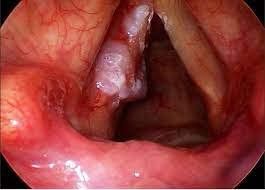This is an automatically translated article.
Head and neck cancer is a group of malignancies that includes many different types of cancer. Prognosis and treatment will vary depending on the type of cancer, the stage of the disease, and many other factors.
1. What are the signs suggesting head and neck cancer?
Wet surfaces inside the mouth, nose, and throat are the most common sites for head and neck cancer to develop. Salivary glands also have cells that become cancerous, but that is rarer. Symptoms suggestive of head and neck cancer include:
A lump in the neck or a sore in the mouth that won't heal; Hoarseness or itchy throat that doesn't go away; Pain in the neck, jaw, or ears; Frequent nosebleeds or stuffy nose.
2. What are the risk factors for head and neck cancer?
If you regularly drink alcohol and use tobacco, you have a higher risk of head and neck cancer than people who do not smoke, drink alcohol. People infected with the human papillomavirus (HPV) also have a higher incidence. Poor oral health can also increase the likelihood of disease.

Ung thư vùng đầu cổ là một nhóm bệnh lý ác tính
3. Types of cancer in the head, face and neck area
3.1 Oral cancer This type of cancer will affect the lips, gums, front two-thirds of the tongue, cheeks, lining of the lips, under the tongue, and the roof of the mouth. As a result, your dentist may be the first to spot the problem. Early signs include a lump or sore that won't heal and you may see a red or white patch on your gums or inside your cheek. If your dentures suddenly don't fit properly, it could also be a sign of oral cancer.
To diagnose oral cancer, your doctor may order an endoscope, which uses a long, thin tube with a light and lens attached to get a better look at your mouth. Your doctor may also take a sample to examine under a microscope. Treatment for oral cancer involves surgery to remove the tumor and abnormal tissue that has spread to other areas such as lymph nodes in the neck or nearby bone. Next, the patient usually receives radiation therapy to kill any remaining cancer cells or stop their growth.
3.2. Laryngeal cancer Hoarseness, difficulty swallowing and lumps in the neck are among the symptoms of laryngeal cancer. Your risk is higher if you use tobacco, drink alcohol regularly, breathe in wood dust, metal dust, or paint fumes at work. Laryngeal cancer occurs more commonly in men than in women.
To diagnose the disease, doctors often order endoscopy. Laryngoscopy provides the doctor with a close-up view of a patient's larynx. Your doctor will also take a sample of cells to examine under a microscope.
Treatment for laryngeal cancer includes surgery, radiation therapy, and chemotherapy. The type of surgery will depend on the individual case of each patient. New treatments being tested include drugs to reduce the risk of cancer coming back (chemotherapy) and drugs that make radiation work better (radiation sensitizers).

Ung thư thanh quản là 1 trong những bệnh ung thư vùng đầu cổ thường gặp
3.3. Oropharyngeal cancer The pharynx extends from the back of the nose to the tip of the esophagus. It is divided into 3 parts: nasopharynx (behind the nose), pharynx (behind the mouth, base of tongue and tonsils) and hypopharanx (bottom part). Nasopharyngeal cancer is more common in Asian, African and Mediterranean countries.
If your doctor suspects you have a problem with your nasopharynx, they will do a detailed examination of your head and neck. You can also get tested for viruses that are associated with the disease, such as Epstein-Barr, HPV. Other tests for diagnosis include laryngoscopy or nasal endoscopy. As with other head and neck cancers, surgery, radiation therapy, and chemotherapy are standard treatments. Alternatively, you may be prescribed a targeted therapy called a monoclonal antibody. They are made from cells of the immune system and sent into your body to attack cancer cells.
3.4. Nasal cavity cancer Cancer cells can develop in the tissue behind your nose (nasal cavity) and hollow areas in nearby bone, called the paranasal sinuses. Symptoms include ongoing congestion, sinus infections that don't go away with treatment, headaches, swollen eyes, and problems with the sense of smell.
You may have a nasal endoscopy to check for abnormal areas. Your doctor may also perform a biopsy called fine-needle aspiration (or FNA) to remove some fluid or tissue and examine it under a microscope. X-rays and magnetic resonance imaging (MRI) to take a closer look at the abnormal area can also help diagnose the condition. As with other head and neck cancers, surgery, radiation therapy, and chemotherapy are standard treatments.
3.5. Salivary gland cancer The salivary gland is located in the floor of your mouth and near your jawbone and is responsible for making saliva. Symptoms of this type of cancer include pain, numbness, or weakness in the face. You may also have trouble swallowing or opening your mouth wide. Fluid discharge from the ear is also another sign of this pathology.
To diagnose salivary gland cancer, your doctor will use a needle or small cut to take a part of the problem area and look at it under a microscope. Surgery, radiation, and chemotherapy are standard treatments, but the type of radiation used may depend on the location and extent of the disease.

Ung thư khoang mũi là 1 trong những bệnh ung thư vùng đầu cổ thường gặp
In summary, head and neck cancer includes many different pathologies depending on the tumor location. They can have similar symptoms. Surgery, chemotherapy, and radiation are standard treatments for head and neck cancer. When there are any abnormal signs, immediately go to medical facilities for examination and timely diagnosis. Detecting the disease at an early stage helps to have a better prognosis for treatment.
Currently, early cancer screening is considered the perfect measure in the timely detection and treatment of all types of cancer. Reduce the cost of treatment and especially reduce the mortality rate in patients. Vinmec International General Hospital always deploys and introduces to customers the Early Cancer Screening Package at Vinmec - Peace of mind to live well to help with gene testing, imaging, testing of biomarkers to detect tumors you early.
Choosing the Early Cancer Screening Package at Vinmec - Peace of mind at Vinmec, customers will get:
Only one gene test can assess the risk of 16 common cancers in both men and women ( Lung cancer, colorectal cancer, breast cancer, pancreatic cancer, cervical cancer, stomach cancer, prostate cancer,....); Early detection of early signs of cancer through imaging, endoscopy and ultrasound; The examination operation is simple, careful and accurate; A team of well-trained specialists, especially in oncology, are capable of handling cancer cases. With a system of facilities, advanced and modern medical equipment and a team of doctors with deep expertise and experience, it will help the examination and treatment process of patients at Vinmec become faster with High efficiency, save cost and time.
Please dial HOTLINE for more information or register for an appointment HERE. Download MyVinmec app to make appointments faster and to manage your bookings easily.
Reference source: webmd.com












